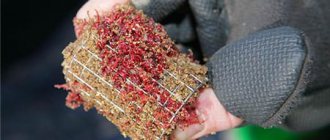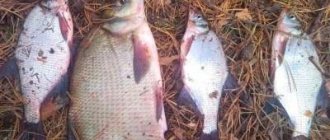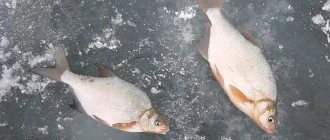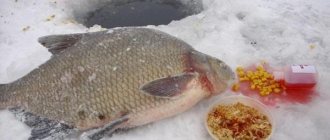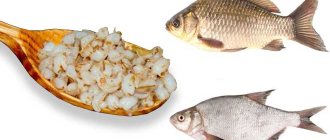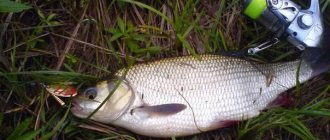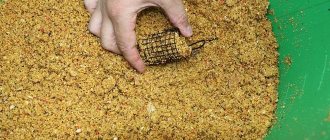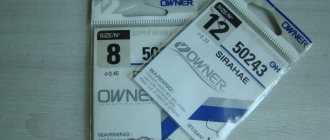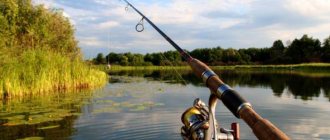- Groundbaits
14660
The shelves of fishing stores are filled with industrial bait mixtures, but, according to many feeder fishing enthusiasts, a good half of them are inferior in effectiveness to the so-called Salapin feeder porridge. In addition, salapinka, as fishermen often affectionately call it, can be easily prepared at home by purchasing all the necessary ingredients at the nearest supermarket. If we talk about cost, this is perhaps the most budget-friendly bait option. The only thing that is cheaper than this is makha, which can be used without mixing it with anything. But will the result be the same as with the salapina? Hardly.
So, everything you need to prepare a simple but very effective porridge can be found in the first grocery store you come across. In this case, the entire set will cost a maximum of 15-20 rubles. For comparison, let’s name a couple of store-bought formulations in the mid-price category. Take, for example, carp Traper or GF. For a kilogram package of each of them you will have to pay at least 150 rubles. As you can see, the difference is more than significant.
Despite the cheapness, Salapin porridge for feeders, or rather its working qualities, evoke real admiration. Once in the water, this bait creates an attractive cloud of turbidity around the feeder; large components disintegrate gradually, so the fish are not oversaturated. Salapina is good not only for feeder fishing with classic feeder feeders, it can also be used in other types of fishing. For example, for such gear as a crucian carp killer, in which springs serve as feeders. Or when fishing with a fly rod, periodically throwing compressed lumps of porridge to the fishing point. The only thing she is not “friendly” with is a strong current. A powerful stream washes it out of the feeder too quickly. There are two ways to combat this: use a design with a small mesh and pack the food more densely.
Who invented Salapin porridge?
Almost everything related to feeder fishing came to us from abroad. The British are the trendsetters in this direction, so you might think that the salapina was also created by some Harry Smith. But in fact, the author of this catchy composition is Russian citizen Dmitry Salapin, an avid fisherman and blogger who actively promotes English bottom fishing. His famous recipe has not only been floating around fishing sites for the last few years, many of our fishermen have already appreciated it and expressed their boundless gratitude.
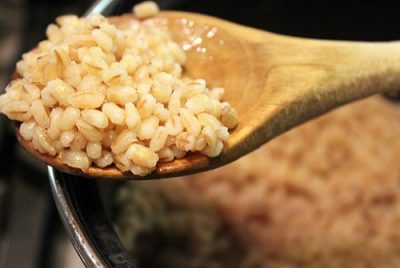
According to Dmitry, he just wanted to prepare an effective bait for bream from improvised products that were found in the kitchen. Fishermen use each of its components in homemade mixtures, but no one has ever tried it in such a combination. The result exceeded all expectations - not only bream, but also other fish of the carp family were caught perfectly. Over time, the porridge became known to the fishing community and was named after its author. In some regions, some feeders try to experiment with its composition, adapting to the conditions and taste preferences of the fished object, but in most cases, fishermen use exactly the basic composition proposed by Salapin.
What bodies of water is the salapinka intended for?
This bait works equally well both in still water and in currents, but for a river you will have to add a binding component to it so that it is washed out gradually. Small cereals, rolled oats or cornmeal are suitable. On the lake there is no need for such a component; here the food, on the contrary, should be more crumbly.
Particular attention should be paid to the color of the porridge. It is based on different grains, so it can create too strong a contrast with the dark bottom. To eliminate this problem, you will need food coloring, but you should not be too zealous with it. Just changing the shade a little is enough.
In general, you can add anything to the salapinka (at your discretion), but within reasonable limits, otherwise there is a risk that the famous bait will have the opposite effect.
Using porridge when fishing for bream
The purpose of using bait is not to feed the fish, but to attract and hold it near the tackle for as long as possible. An important point is the correctly selected design of the feeder for the current fishing conditions. It is necessary that the porridge dissolves in standing water, and in a river it does not quickly wash out of the feeder and is not carried far away by the current.
Bream loves quiet, warm water with a muddy or clayey bottom. At the beginning of summer, during spawning, it leaves the rivers or lives in grassy and low-lying places, in standing water - near reeds. Closer to autumn, it finds holes and stands in them until winter, leaving only for food. Therefore, you need to look for bream near holes, on a clayey and silty bottom, near reeds and grass thickets.

In stagnant water, the bait should dissolve very slowly, otherwise the bream will quickly get enough and go back without trying the bait. When fishing on muddy ponds, it is useful to add sand to the bait, since bream loves water turbidity. And the sinking sand will disperse the silt a little, making the bait with the nozzle more noticeable. To make the porridge more flavorful, it is recommended to use it warmed up, even in the sun, but you cannot store it in direct sunlight for a long time in the summer - it is fraught with souring.
Classic recipe and preparation for bream and crucian carp
Today, there are many variations of Salapin porridge based on the same cereal base. Dmitry once offered fishermen the following recipe for bream, crucian carp:
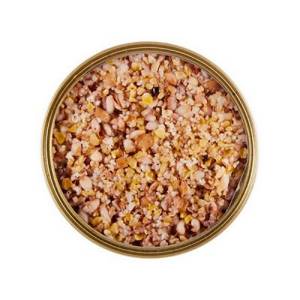
pearl barley – 100 g (0.5 cup);- corn grits – 300 g (1.5 cups);
- millet cereal – 200 g (1 cup);
- barley – 200 g (1 cup);
- vanillin – 10 g sachet;
- sunflower oil (unrefined) – 2 tbsp. spoons;
- water – 1 liter.
Advantages and differences from other baits
Salapinka contains pearl barley. Its large grains can attract big fish, because not all small fish are able to swallow swollen pearl barley. The second feature of mixed water is its significant decay time, even during currents. The food cloud stays around the fishing spot longer than when using most other baits.
Other features of the recipe include low cost. The ability to monitor freshness, ease of preparation and the presence of large fractions to attract large fish are the advantages of salapin over purchased baits.
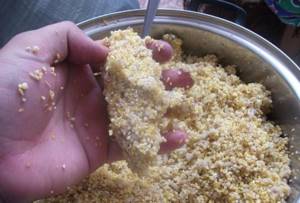
Thanks to its large structure, Salapin porridge attracts large species of fish
Additional Ingredients and Flavorings
Fans of the English donkey are always guided by the rule: feed with what you catch. That is, if the attachment is peas, corn grains or wheat, then they will not interfere with the porridge either. But no more than 10% of the total volume, otherwise it will be a completely different bait. It's not a fact that it's working.
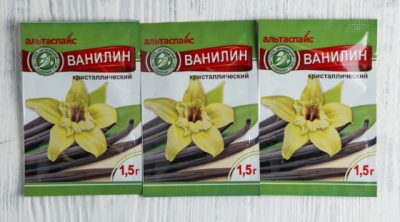
In addition to vanilla, various additives with a strong odor are used as flavoring agents. In the spring and at the end of the open water season, spicy aromas - dill, anise, garlic - work well, and in the midst of the summer heat it is better to give preference to sweet ones - honey, cinnamon, caramel, strawberry and the like. It is important to choose exactly the smell that the object of fishing likes and corresponds to the time of year.
Salapin porridge for bream feeder - classic recipe
Today, there are many variations of Salapin porridge based on the same cereal base. Dmitry once offered fishermen the following recipe for bream, crucian carp:
- pearl barley – 100 g (0.5 cup);
- corn grits – 300 g (1.5 cups);
- millet cereal – 200 g (1 cup);
- barley – 200 g (1 cup);
- vanillin – 10 g sachet;
- sunflower oil (unrefined) – 2 tbsp. spoons;
- water – 1 liter.
At the first stage, the required amount of water is poured into a pan with a volume of about 5-6 liters. Now you need to wait until the water boils. When this happens, add pearl barley and reduce the heat so that the mixture does not boil too much. If this is not done, the porridge may burn.
Cover the pan with a lid and wait until the pearl barley is cooked.
It can be considered cooked when the water becomes cloudy and the edges of the grains are transparent. When everything is finished with the pearl barley, a mug of millet is poured in there. To prevent the cereal from sticking together into one large lump, it is necessary to stir it regularly during the first moments while it is in the water.
Just a couple of minutes later, sunflower oil and vanillin are added to the mixture. This porridge should simmer over very low heat. The porridge will be almost ready when there is almost no water left in it, and small holes begin to appear. As soon as this happens, the fire is extinguished, the pan is tightly closed with a lid and left for approximately 20-25 minutes.
During this time, the porridge should absorb all the remaining water. If this does not happen, then the water must be drained. Now barley and corn cereals are added to the composition. Barley is added in the area of one mug, and corn - one and a half. The resulting mixture is thoroughly mixed.
The end result is a crumbly mixture, but if you squeeze it, it forms a lump.
If the mixture is not too crumbly, you need to add a little more cereal. A very crumbly composition is also not very good, so you will need to add a small amount of steamed rolled oats.
In order for the bait to work out, it must be prepared in a certain sequence. Namely, the preparation of porridge is as follows:
- Pour water into a saucepan, put it on the stove and bring it to a boil;
- Add the pearl barley and cook until half cooked (until the surface of the grains becomes soft, this will take about 15-20 minutes);
- Add vanilla to the container, pour in sunflower oil;
- Add millet and mix;
- When the millet has absorbed almost all the water and begins to slowly boil, turn off the heat and cover with a lid;
- After a quarter of an hour, check the readiness of the porridge (instead of water there will be characteristic “wells” created by air bubbles);
- Mix the egg and corn grits in a separate dry container (it should be spacious, something like a basin, so that it is convenient to mix the components);
- Pour the cooked barley and millet porridge into it, mix everything thoroughly at once (it is important to do this before the porridge cools);
- Return the mixture to the pan, cover and leave on the still warm stove to allow the grains to swell.
After some time, the main components of the mixture will reach readiness and will be saturated with the aroma of sunflower oil and vanilla.
Salapin porridge for catching bream with a ring or feeder is ready! This is a base that is not prohibited from being modified at your own discretion. The main thing is not to spoil it.
Consistency
There are two extreme options here:
- The porridge does not stick together into lumps at all;
- It sticks together so that it is impossible to unstick it.
Ideally, prepare the composition in such a way that the porridge sticks well into a lump, but with strong pressure it should crumble. If the preparation technology has been followed completely, then a similar composition will be obtained the first time. If suddenly something goes wrong, the viscosity of the porridge can be slightly changed.
Corn grits are added to those that are too viscous, and rolled oat flakes are added to crumbly ones. Instead of steaming, you can simply grind them into dust.
How well the porridge will work in water can be judged as follows: a ball formed from the prepared composition is placed in water. If the bait begins to gradually crumble and disperse throughout the volume of water, this means that it functions quite well and will work to attract fish to the fishing spot.
Additional Ingredients and Flavorings
Fans of the English donkey are always guided by the rule: feed with what you catch. That is, if the attachment is peas, corn grains or wheat, then they will not interfere with the porridge either. But no more than 10% of the total volume, otherwise it will be a completely different bait. It's not a fact that it's working.
In addition to vanilla, various additives with a strong odor are used as flavoring agents. In the spring and at the end of the open water season, spicy aromas - dill, anise, garlic - work well, and in the midst of the summer heat it is better to give preference to sweet ones - honey, cinnamon, caramel, strawberry and the like.
It is important to choose exactly the smell that the object of fishing likes and corresponds to the time of year.
It doesn’t matter if the Salapin porridge prepared the evening before was not needed due to the cancellation of fishing. It will “live” quietly in the refrigerator for a week and will not lose its quality. For longer storage, the finished bait will have to be dried on a windowsill on the sunny side, spreading it on paper in a thin layer.
This way it will look like the one they sell in the store. On a pond, you just need to add a little water and wait a few minutes. Various additives can be added to Salapin porridge. Moreover, they can be either universal or used exclusively for one type of fish in a specific season.
Universal additives are:
- Peas, bream actively bite on them;
- Semolina;
- Steamed wheat;
- Honey;
- Cake;
- Linseed oil;
- Walnuts. They significantly increase the appetite of crucian carp;
- Ground crackers;
- Seeds;
- Hercules porridge;
- Gingerbread.
To attract fish in spring and autumn, you can additionally use the following flavoring additives and flavorings in the porridge:
- Garlic;
- Dill;
- Anise;
- Ground roasted sunflower seeds.
In the spring, fishing will be much more effective if you add a small amount of finely chopped worms, maggots or bloodworms to the Salapin porridge, immediately before casting. In addition, a little clay from the reservoir in which fishing is carried out should be added to the porridge.
This will prevent the fish from becoming saturated too quickly and will increase the chances of catching a large fish.
In summer, it is recommended to use honey, tutti-frutti flavoring, cream, strawberries, cocoa, banana, caramel, and peach as additives to Salapin porridge. When supplementing Salapin porridge with various auxiliary ingredients, it is important to remember that the bait should not turn out tastier than the bait. Source: “vsegdanarybalke.ru; pohod-lifehack.ru; klevoklev.com"

